You are reading the older HTML site
Positive Feedback ISSUE
15
september/october 2004
purist audio designs
Venustas interconnect, speaker, and AC cables
as reviewed by Vade Forrester
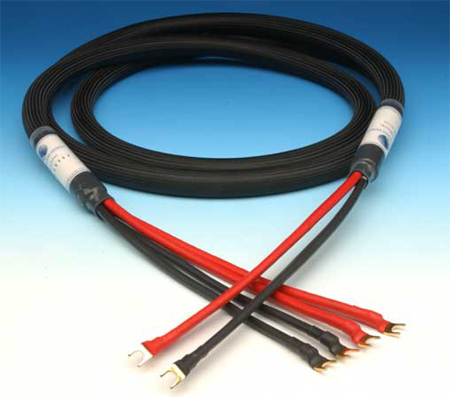
VADE FORRESTER'S SYSTEM LOUDSPEAKERS ELECTRONICS SOURCES CABLES ACCESSORIES
|
Warning! Do not listen to these cables unless you are serious about buying them. After auditioning the Venustas cables, returning to lesser ones could leave you highly dissatisfied with the sound of your audio system. You've been warned.
The Venustas cables are in the middles of Purist's product line, but they are serious cables. Their price is also serious, though not out of line with mid- to high-priced audio equipment. Of course, "mid- to high-priced" is a relative term. Purist's CEO, Jim Aud, informed me that the word Venustas is taken from the earliest known work about architecture, Vitruvius' On Architecture. Appropriately, it means "beauty."
The Venustas cables are packaged in heavy-gauge plastic bags, each with its own registration form. I don't know about you, but I prefer to see my money go to performance instead of designer speaker boxes, which I usually throw away.
Like the Purist Musaeus cables I reviewed in Issue 14, the most distinctive characteristic of the Venustas cables is the use of a material called Ferox to shield the conductors from EMI/RFI and from vibration. The other feature is a treatment called Cryomag©. Purist began cryogenically treating cables in 1995, before most companies even knew about the treatment, and now augments it with a "proprietary process in which the cables are subjected to lower temperatures in a controlled magnetic field; the ultimate goal being to align the crystal structure of the materials."
Power Cords (2-meters, $1000)
The power cords are the only Venustas cables that don't use Ferox shielding. They are surprisingly light. The AC and IEC plugs are made by Kimber, and grip their respective connectors very firmly. That, together with the light weight, means that the cords don't tend to get pulled out of the IEC socket or the wall. Though large, the Venustas power cords can be easy twisted to align the connectors with the IEC connectors on your equipment. Figure 1 is a cutaway drawing of the cable, while Figure 2 shows the finished product.
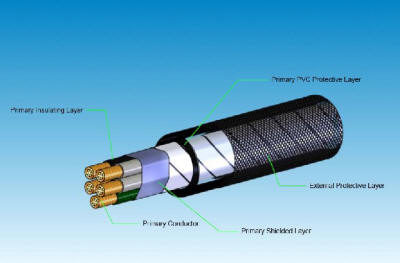
Figure 1
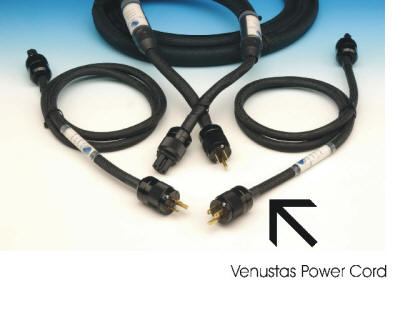
Figure 2
-
Conductor: stranded, multi-gauge alloy
-
Metals: copper
-
Shielding: aluminized foil layer
-
Dielectric: polyvinyl chloride
-
Gauge (effective): 10 AWG
-
Current capacity (DC) (cable only): 30 A @ 75∞C
-
Overall current capacity: 15 A with 15 amp IECC / 20 A with 20 amp IECC
-
Resistance: 4.298 mΩ/m per conductor
-
Break-in time (hours): 75
-
Material treatment: Cryomag©
Speaker cables (2.5-meter pair, $2460)
When I took these out of the shipping box, I worried about getting another hernia. There ís obviously a lot of Ferox in these babies, yet they are still rather flexible. The conductors, which are effectively 8-gauge, are stiff and a little difficult to bend into a shape that would connect to my amplifier. I persevered, and finally got the cables to stay connected. Figure 3 is a cutaway drawing of the speaker cable, while Figure 4 shows the finished product.
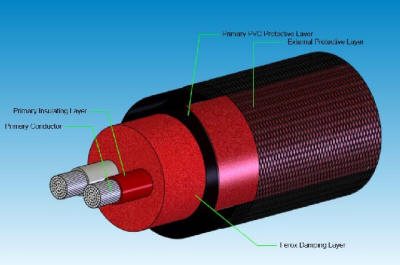
Figure 3

Figure 4
-
Conductor: stranded, multi-gauge alloy
-
Metals: copper, silver
-
Shielding: Ferox
-
Dielectric: Teflon©
-
Gauge (effective): 8 AWG
-
Current capacity (DC): 45 A @ 200∞C
-
Resistance: 2.4 m & 2.4 mΩ/m per conductor
-
Break-in time (hours): 125
-
Material treatment: Cryomag©
Interconnects (1--meter pair, $1425)
The interconnects are thick, but surprisingly light and flexible. They are terminated with Purist RCA plugs, which are made of the same materials as the conductors and silver-plated. Like the Musaeus plugs, these do not lock, but they never failed to tenaciously grip the jacks I offered them, including the grotesquely large ones on my Audio Note AN-S3 step-up transformer. After disconnecting the interconnects from these large jacks, the Purist plugs still gripped normal RCA jacks firmly. If all RCA plugs worked this well, we wouldn't need locking plugs (if we do now). Figure 5 is a cutaway drawing of the interconnects, while Figure 6 shows the finished product.
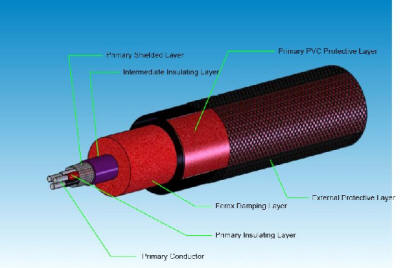
Figure 5

Figure 6
-
Conductor: stranded, multi-gauge alloy
-
Metals: copper, silver, gold
-
Shielding: Polyester wrap, braided silver-plated copper with 90% coverage, Ferox
-
Dielectric: Teflon©
-
Gauge (effective): 18 AWG
-
Capacitance: 246 pF/m ±15% (pin-to-shield)
-
Resistance: 25.25 mΩ/m (conductor)
-
Break-in time (hours): 105
-
Material treatment: Cryomag©
Phono cable (1.2-meter set, $1775)
I was delighted to learn that Purist offered a tonearm cable, since I suspected that the cable that came with my Graham arm was doing grave damage to the sound of my turntable. The cable was terminated on one end in a DIN plug to attach to the base of my tonearm, and the two channels are gathered to from a single cable about ten inches long that fit nicely into the P-clip that snugs it firmly to my Linn turntable's suspension. It then exits the base, where it splits into two cables that look like standard Venustas interconnects. Jim Aud was particularly proud of his phono cable, having spent eight months developing it. Replacing the Graham cable was relatively easy for a Linn turntable. Figure 7 is a cutaway drawing of the phono cable, while Figure 8 is a drawing of the finished product.
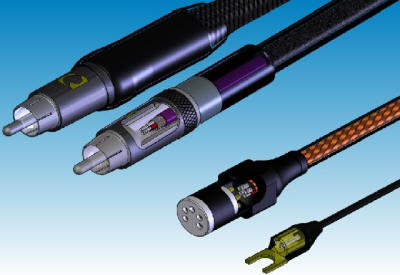
Figure 7
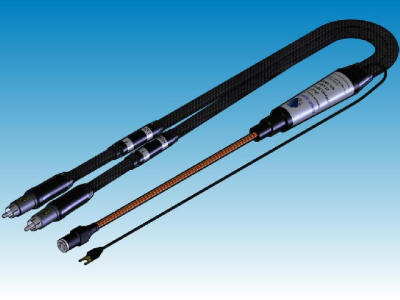
Figure 8
-
Conductor: stranded, multi-gauge alloy
-
Metals: copper, silver, gold
-
Shielding: Polyester wrap, braided silver-plated copper with 90% coverage, Ferox
-
Dielectric: Teflon©
-
Gauge (effective): 18 AWG
-
Capacitance: 246 pF/m ±15% (pin-to-shield)
-
Resistance: 25.25 m & m (conductor)
-
Break-in time (hours): 105
-
Material treatment: Cryomag©
The burn-in times given above proved to be accurate. The worst case were the speaker cables, which I burned in on my homemade cable burner, using Purist's latest System Enhancer Rev-B disc to generate a signal. I daisy-chained the interconnects and made an adapter for the phono cable that let me insert it into the daisy chain. Then, 125 hours later, I wired up the system (except for the turntable) and started to listen. I didn't hear any significant change to the sound of the cables after burn-in.
Evaluating the Venustas cables was one of the easiest reviewing tasks I have had, because they were so much better than any other cables I have heard. I played many of my standard tracks through the Venustas, along with some new choices, and while I'll mention a few pieces, I had the same general observations about the sound of the Venustas cable with all of the music I played.
Quietness is the Holy Grail of all Purist designs, and is probably the foundation for most of the attributes that follow. In cables, quietness differs from quietness in electronics, where noise takes the form of hum or hiss. Cable noise has a masking effect that obscures the musical information that passes through the system. Using the Venustas was like removing a layer of distortion from the sound. What remained was pure music, which emerged from the proverbial black background.
My first impression of the Venustas was that they allowed the system to transmit a huge amount of musical detail. Instruments and voices sounded more real, and had a clearer tonal structure, yet this detail was not achieved by artificially boosting the high frequencies. These cables provided genuine detail about the musical performance—the tone, the tempo, the space, and all of the other subtle details of the recorded performance. The information conveyed by the Venustas cables made musical sense. Melody lines, harmonies, and tempos were easy to follow. The wealth of information was always presented in the context of the music, and made the music sound more real. The harmonic structure of instruments and voices was more accurate than with any other cable I've heard.
This was due at least in part to the vivid detail that was the Venustas' primary characteristic. The very slight modulations that give character and life to the sound of instruments were laid out clearly, but not analytically, for the listener to enjoy. The tonal palette was subtle, and strikingly realistic. As a former trumpet player and current attendee at many live, unamplified concerts, I am familiar with the sound of instruments, and the methods that players use to modulate those sounds to express themselves. The Venustas make such things easily discernible, and this makes the music more enjoyable.
The detail exhibited by the Venustas cables extended into the vital area of the attack and decay of notes. One example was the very high-frequency chimes in "The Panther," on Jennifer Warnes' The Well (Cisco SCD 2034, CD layer) and LP (Cisco CLP 7009). Through lesser cables, the chimes were clearly delicate, high-frequency sounds, but through the Venustas, I could hear how each note began with the striking of the chime and ended with vibrations dwindling off into silence.
The quietness and the detail revealed by the Venustas cables made the performers appear to be standing in front of me, singing or playing instruments. Pardon the audiophile cliche, but it really applies to the Venustas. Larger-scaled music like symphonic works sounded as if they occurred in larger acoustic spaces, with the appropriate resonance. Voices were superb, and I could easily follow vocal lines through complex passages. I could also understand words better. The quietness made voices, in particular, sound free of distortion.
The Venustas gave my ReTHM speakers (which sorely need it) an extra half-octave extension in the bass, making the departure of my subwoofer even more likely. The added bass was not just a barely perceptible extension—it provided enough weight and body to make lower-register instruments sound appropriately powerful. The bass detail was amazing, but always a coherent part of the overall performance. Micro- and macro-dynamics were both present in abundance, but so well integrated into the music that I had to consciously focus on that aspect of the sound. That is as it should be, but seldom is.
A sharp-eared listening buddy who is very familiar with my system pinpointed the fact that the Venustas cables possess a relaxed sound. It is probably another result of their incredible quietness that music through the Venustas always sounded strain-free. There was no boosting of the highs to create an artificial sense of detail. Perhaps the best way to summarize the capabilities of the Venustas cables is simply to say that they make it more fun to listen to music. I can't think of higher praise for any hi-fi component!
I will mention a few pieces of music that best illustrate the character of the Venustas cables. In the famous Canon by Pachelbel, from the CD Popular Masterworks of the Baroque, performed by Tafelmusik (Reference Recordings RR-13 CD), strings were rich and rosiny, with accurate instrumental color. When the first violin dug into a note during one of the passages, it really sounded like a violin—a baroque violin, mind you, not a modern one.
"Rodrigo Martinez," from the CD La Folia by Jordi Savall (AliaVox AVSA 9805), is one of my standard torture tests for hi-fi systems, but the Venustas brought it to its knees. For the first time ever, I could follow musical lines throughout this very busy piece, which in the past has often sounded like a mere jumble of notes. I could make sense out of the musical lines of each instrument. The bass drum was deep and resonant, but somewhat less sharply defined than a modern drum, which has tighter heads. This information-rich CD provided more information via the Venustas than I got when I played the piece on an SACD player. (It is available on SACD as well as standard CD.)
The song "I Can't Hide," from Jennifer Warnes' CD The Hunter (Private Music 01005-82089-2) is one of my favorite test cuts because it has fairly deep bass, extended highs, dynamic instruments, and most importantly, Jennifer herself, recorded in a well-defined acoustic space. The Venustas gave the song an extra half-octave of bass, with impressive detail and weight, not just a barely perceptible thud.
My standard symphonic test cut, "March to the Scaffold," from Hector Berlioz' Symphonie Fantastique, played by the Cleveland Orchestra under the direction of Pierre Boulez (Deutsche Grammophon 453 432-2), exhibited more orchestral detail through the Venustas, as though a veil of distortion had been removed. Celli and basses had unusually good weight and depth. The tympani (which may be overemphasized in this recording, but that's why I like it so much) rolled dramatically, from a barely perceptible level to one that overwhelmed the entire orchestra. I could easily hear each strike of the drumsticks on the heads of the tympani, at both the soft and loud ends of the dynamic range.
Of all the Venustas products, the phono cable is the one I would buy first. It literally rejuvenated the sound of my LP collection and reawakened my interest in listening to LPs. The thin, unattractive sound I had been hearing from LPs was replaced with a weighty, fast, detailed, and smooth sound that brought them back to life.
I carefully leveled my turntable and dropped the cartridge onto my new LP copy of Eva Cassidy's Songbird (S&P Records S&P 501). The sound was oh so smooth, and very strong on the bass end. In fact, it was way too strong—I had cranked the arm all the way down to try to compensate for the pinched, thin sound of the Graham IC-30 cable, which had never adequately delivered the bass of which my Dynavector cartridge is capable. It became clear that a resetting of VTA was in order.
As a starting point, I cranked the arm up until it was horizontal to the LP surface. The sound was too bright and brittle, so I lowered the back of the arm slightly. An overly strong bass and lack of highs made it clear that I had passed the ideal VTA setting, so I raised the arm base until the balance between highs and lows sounded right. I then noticed that there was a hole in the middle of my soundstage, so I raised the arm a little more until the hole filled in, at which time the VTA was pretty well set, though of course I continued to tweak it until I had convinced myself it was just right. The Venustas phono cable unequivocally revealed the sonic effect of even the slightest change in VTA.
In the song "Fields of Gold," Eva Cassidy's ethereal voice was precisely located in space. While very smooth, her voice was also very detailed and articulate. It was easy to hear each string of her guitar as she plucked it, and how each note decayed into silence. None of these details were spotlighted. Instead, they were an integral part of the performance. I can't overemphasize this point—all of the wealth of detail and spatial information the Venustas passed on was totally integrated into the musical performance, and was not emphasized in any way.
After recalibrating my VTA, I found myself hunting up LP after LP to renew my acquaintance with old friends. This made for some rather late nights, but hey, I'm an audio reviewer, and don't have another job to go to in the morning! This is only a sample. The actual list was much longer, and grows longer daily. Since it is one of my favorite records, I have both the CD and a copy of Cisco's LP pressing of Jennifer Warnes' The Well. On the LP, her voice is even smoother, and the bass more robust, than on the CD. The highs, as portrayed on "The Panther," sparkled when the chimes were played. The soundstage was continuous, and the performers' positions within it were firmly fixed.
I have fond memories of Frederick Fennell, since as a trumpet player in my high school band, I attended a band clinic he conducted. Our band played one of Holst's Suites for Band, a piece he had recorded on his monophonic Mercury LP, British Band Classics. His coaching must have been effective, since we won first place in a interscholastic league competition, but that's enough reminiscing. On Lincolnshire Posey, played by the Cleveland Symphonic Winds under Fennell's direction (Telarc DG-10050), the soundstage was broad and spacious. The famous—or infamous—Telarc bass drum whacks (Fennell loved the bass drum) had real weight, and went as deep as I've ever heard my ReTHM speakers go, at least with my Art Audio amp, which started to clip when I got too enthusiastic with the volume control. Six watts only goes so far, even on 104 db efficient speakers! Clarinets had a realistic reediness that bespoke accurate tonal color. Macro-dynamics were huge, yet undistorted, though I suspect the Dynavector cartridge should get some of the credit for that. Orchestral chimes rang out over the full orchestra, and their notes decayed in space for a long time after the orchestra stopped playing. Not bad for an early digital recording!
Another early digital recording from Telarc, Carmen Suite, played by Leonard Slatkin and the Saint Louis Symphony (Telarc Digital 1048), features the formidable Telarc bass drum, which always gets my audiophile juices flowing. Through the Venustas, the drum was so powerful that I again asked myself why I had purchased that subwoofer. Chimes rang out clearly, strings were lush. During the flute and harp duet, both instruments had excellent tonal color, and sounded very realistic. All this on a recording from the early days of digital—albeit a Soundstream recording, which sort of went away when later systems were developed.
Witches' Brew (Classic Records reissue of RCA LSC 2225) is an audiophile favorite, and it is undeniably exciting, even though some of the sonorities from this 1958 recording sound a little strange to me. The triangle tinkled brightly, the trombone blared forth proudly, underpinned by strong drum rolls. While listening to this LP, I realized that the VTA adjustment needed further tweaking, and the Venustas cable not only made this evident, but made it easy to improve the setting.
I used the Venustas in a system with cables from Silver Circle Audio, Blue Marble Audio, and PS Audio. Even when used with these other cables, the Venustas always improved the sound. It would probably be best to use Venustas cabling throughout the system, but that could get quite expensive, so it's nice to know that mingling Venustas with lesser cables still results in dramatic sonic improvement. This brings me to an important issue—the one of expense. The set of Venustas cables I evaluated cost over $10,000. In my system, which probably costs $60,000, that is a sizable percentage. As I see it, there are two compelling reasons to consider buying the Venustas cables. The first is that you would probably get more improvement by spending $10,000 on Venustas than on other component, and the improvement would apply to all parts of the system, not just the single component.
The second is that without the resolution and detail provided by the Venustas, cables, any improvements you might make from installing a new CD player or preamp could not be fully heard through lesser cables. The Venustas cables are enablers for superb sound. If you can't afford a system's worth of Venustas cable, you could still make incremental improvements by getting into the Venustas cables piecemeal. You could upgrade one step at a time, realize improvements with each, and stop when your system is completely Venustasized, at least until you listen to the Dominus cables, which Jim Aud informs me are as much an improvement over the Venustas as the Venustas are over the Musaeus.
I now have to chuckle at my review of Purist's Musaeus cables, in which I stated that I couldn't imagine how anyone could make a better-sounding product. The Venustas cables sound more than sensational—they are transformational. I have not heard such a dramatic improvement in my hi-fi system in years, if ever, and never as much improvement in a single step. It makes listening to music of every kind more fun, and has restored my enjoyment of LPs. The Venustas cables opened my eyes and ears to the fact that cables can be much better than I had suspected. Therefore, the Venustas cables get my very highest, most wildly enthusiastic recommendation, but before you seek them out for a listen, remember my warning. Vade Forrester
Purist Audio
Designs
TEL: 979. 265. 5114
web address:
www.puristaudiodesign.com
